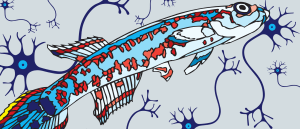Longevity lingers in the lysosome

Changes in Caenorhabditis elegans lysosome metabolism can be carried through generations via inherited histone modifications.
A team of researchers from the Howard Hughes Medical Institute (MD, USA), led by Meng Wang, has uncovered a mechanism by which worms can pass down genetic-engineering-induced longevity to their progeny, without passing on the specific genetic modification. This research could shed light on the mechanisms behind life-span-related transgenerational effects in humans.
In certain model organisms, malnourishment has been observed to induce epigenetic changes that lead to their offspring living longer. This phenomenon is known as a transgenerational effect: typically, an extreme stimulus in an individual’s life, such as stress or pollution, which elicits an outcome in their progeny. These effects have been observed in both humans and model organisms; however, their mechanisms have not been well understood.
In order to better understand this phenomenon and the traits surrounding longevity, the team decided to build on previous work showing that when they overexpressed the lysosomal enzyme LIPL-4 in the intestine of C. elegans, they could extend the life of the roundworm by 60%. However, they had noticed that when these worms were bred with wild-type worms to “wipe clean” this genetic alteration, their offspring also displayed elevated longevity.
To investigate how these traits of longevity were carried down through generations, the team first used chromatin immunoprecipitation followed by next-generation sequencing (ChIP-seq) to identify and validate that in long-lived C. elegans, the histone variant H3.3 was elevated in expression and was methylated on the K79 position in the long-lived worms. With a target identified, the team applied genetics, transcriptomics and imaging techniques to establish how the lysosomal protein changes they induced led to this change.
 Identifying key hallmarks of the aging brain
Identifying key hallmarks of the aging brain
A study of killifish reveals how protein dysfunction develops in vertebrate brain cells, a key driver of aging.
Through this approach, they established that the upregulation of LIPL-4 and the activation of lysosomal adenosine monophosphate-activated protein kinase (AMPK) or the inhibition of lysosomal mechanistic target of rapamycin (mTOR) signaling were responsible for these changes, identifying the upregulation of a constituent gene of the H3.3 complex, his-71, as the key to this impact.
The team engineered a transgenic strain that expressed a FLAG-tagged version of his-71 in the intestine, but not in the germline. They then conducted immunostaining with anti-FLAG antibodies and found the tagged his-71 in oocytes of the dissected transgenic strains. Further knock-out experiments revealed vitellogenins, large lipid transfer proteins tasked with providing nutrients to developing eggs, which are synthesized in the intestine and transported into oocytes via the lipoprotein-like endocytic receptor RME-2, were key to this transfer of his-1 from the intestine to the germline.
Once in the oocytes, a germline-specific H3K79 methyltransferase was identified as being responsible for methylating the H3.3 variant and leading to the same overexpression that enabled extended lifespan in the parent to be passed onto their progeny.
“You always think that your inheritance is in the nucleus, within the cell, but now we show that the histone can go from one place to another place, and if that histone carries any modification, that means you are going to transfer the epigenetic information from one cell to another,” Wang explained. “It really provides a mechanism for understanding the transgenerational effect.”
Wang’s team also found that this pathway was activated during fasting, providing a link to how parental physiological changes can affect their children.
“We now show that the soma and the germline can be connected by the histone and can carry memorable genetic information for generations,” Wang concluded.